![]()
![]()
![]()
Use LEFT and RIGHT arrow keys to navigate between flashcards;
Use UP and DOWN arrow keys to flip the card;
H to show hint;
A reads text to speech;
116 Cards in this Set
- Front
- Back
|
What is and is not considered science?
|
Astrology is science; Astrology is not science
|
|
|
What is science?
|
-Objective inquiry into phenomena concerning the natural world
-It involves events that can be traced to natural causes that are potentially within our ability to study and comprehend |
|
|
What is not science?
|
-Examining supernatural phenomena
-Astrology, religion, or faith-based assertions -Other disciplines are responsible for studying these |
|
|
What are the three principles of science?
|
1. Limited tot he explanation of physical/natural phenomena (natural causality)
2. Assumes fundamental processes are uniform across time and space (i.e. gravity) 3. Science is purely objective (no morals, ethics, values, etc) |
|
|
What are the steps involved in the scientific method?
|
-Observation: Scientists make an "observation" or notices something
-Question: Observation leads to a question: Why? How? -Hypothesis: One or more possible (testable) explanations or answers -Prediction: Leads to a testable prediction: if...then... -Experiment or Observation: Designs a way to test a prediction (use controls if possible) -Conclusion: Do results support hypothesis or not? |
|
|
How do different branches of science interact?
|
It's impossible to study in isolation of other sciences
-e.g. Geology, physics, astronomy, and chemistry are inter-related to biology (life) |
|
|
What is the organization of life into a hierarchy of complexity (simple-complex)?
|
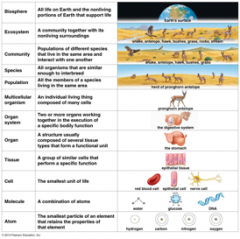
Atom, molecule, cell, tissue, organ, organ system, multicellular organism, population, species, community, ecosystem, biosphere
|
|
|
Which steps contain actual living organisms?
|
-No other level (except organism) can be an organism
-A single cell can be an organism (e.g. bacteria, some algae) |
|
|
What are the six characteristics of life?
|
1. Acquire and use energy and materials from the environment
2. Actively maintain organized complexity 3. Perceive and respond to external stimuli 4. Grow 5. Reproduce 6. Have the capacity to evolve (change) |
|
|
How many of these characteristics must a thing possess to be considered alive?
|
An organism must have all 6 characteristics of life
|
|
|
In science, what is a theory?
|
-A hypothesis that has been tested repeatedly and has always been supported (but could not be falsified)
-Considered a reliable phenomenon -Similar to a law or principle -e.g. theory of gravitation, atomic theory |
|
|
What are the three major biological theories?
|
-Cell theory
-Theory of heredity -Theory of evolution |
|
|
Which theory states that all organisms are composed of one or more cells?
|
Cell theory
|
|
|
Which theory states genetic material (DNA) is passed from parent to offspring (inherited)?
|
Theory of heredity
|
|
|
Which theory states modern organisms are descended, with modification from pre-existing life forms (descent with modification)?
|
Theory of evolution
|
|
|
What is a unique substance that can be broken and changed by natural processes?
|
Elements
|
|
|
What is the smallest particle of an element that has the characteristics of the element?
|
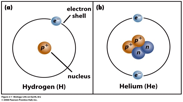
Atom
|
|
|
What subatomic particles make up an atom and where is each of these found?
|
-Neutrons (0), Protons (+), Electrons (-)
-Neutrons and Protons are inside the central nucleus -Electrons orbit around the nucleus/"shells" |
|
|
Why is the number of protons in an atom important? Can this number change naturally?
|
-The number of protons is unique to each element (does not change)
-Number of protons = Atomic number |
|
|
What happens when you vary the number of neutrons in an atom? Can this happen naturally?
|

- An element can have atoms with different numbers of neutrons (different forms)
-No effect on electrical charge -Different forms = isotopes -Some isotopes are stable, others are not -Unstable isotopes = RADIOACTIVE |
|
|
What does the variation in the number of neutrons lead to?
|
Radioactivity
|
|
|
What unstable isotopes will rapidly change to more stable isotopes?
|
Radioactive decay
|
|
|
What is released during radioactive decay?
|

Energy:
-Power (electricity) -Weapons (atomic bombs) Particles released: (alpha/beta/gama) -Can be measured and traced -Can harm and destroy cells/DNA |
|
|
What is it called when radioactive isotopes occur naturally and are used to date artifacts, rocks,..etc?
|
Natural radiation
|
|
|
What is it called when bombarding elements with particles are creating larger nuclei that can lead to the creation of new elements and bombs?
|
Artificial radiation
|
|
|
What is the usage of a PET scan?
|
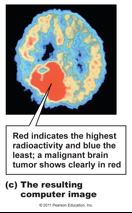
-Ability to measure radioactivity makes it a useful tool in medicine
-Radioactive glucose is injected into a patient -Glucose= sugar the body uses for energy -Site of decay in the body is measured by electrons -Lots of decay at one spot = lots of glucose use (high metabolism) e.g. tumors |
|
|
What are some characteristics of electrons?
|
-Orbit nucleus in shells
-If number of protons = number of electrons, atom is neutral -A shell with an even number of electrons is more stable than one with an odd number -Atoms can lose, gain, and share electrons (increases stability of atoms) |
|
|
How do electrons generate ions?
|
When the number of protons aren't the same as number of electrons the atom has an electrical charge
|
|
|
How would the charge change if an atom gained an electron?
|
Gaining an electron = atom has a negative charge (anion)
|
|
|
How would the charge change if an atom lost an electron?
|
Losing an electron = atom has a positive charge (cation)
|
|
|
Which kind of bond is being described:
-Ions can be attracted/repelled based on charge (like magnets) -Cations and anions interact to form bonds the join atoms together -Weak and easy to break (water is great at breaking this bond) |

Ionic bond
|
|
|
Which kind of bond is being described:
-Strong and hard to break -If electrons are shared evenly then, the bond is considered to be non-polar (neutral all over) -If electrons are shared unevenly then, bond is considered to be polar (+ & - areas exist) |
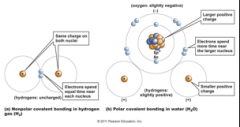
Covalent bond
|
|
|
Which kind of bond is being described:
-Polar covalent bonds produce +/- regions -These "regions" attract/repel (like ions do) and produce very weak bonds -Slightly positive side of a polar molecule is attracted to the slightly negative side of a nearby polar molecule -Very common in water ([+H] side of one water molecule bonds to [-O] side of nearby water molecule |

Hydrogen bond
|
|
|
What is a molecule that has been stripped of electrons that it should have (usually oxygen)?
|
Free radicals
|
|
|
How are free radicals formed?
|
-Produced during normal chemical reactions
-Also caused by exposure to radiation, UV light, some chemicals, etc. |
|
|
What happens to free radicals inside our cells?
|
-Free radicals are highly unstable and will grab electrons from any nearby source to stabilize itself (stealing these electrons makes a new free radical)
|
|
|
Why are free radicals considered to be dangerous?
|
-Chain reactions that can cause damage or destruction of molecules and cells, may promote cancer
|
|
|
What are molecules that react with a free radical and stabilize it, without becoming a free radical (breaking the chain reaction)?
|
Antioxidants
|
|
|
What are a few molecules considered to have antioxidant properties?
|
-Vitamins E and C
-Flavonoids & Carotenoids (cocoa, red wine, yellow/orange/red foods) |
|
|
Which kind of molecules all use covalent bonds, are also called biological molecules, and must have carbon and hydrogen atoms? (Can have other elements, for example: nitrogen, or sulfur)
|
Organic molecules
|
|
|
Which kind of molecules do not have carbon and hydrogen atoms? (Might have one of them, for example: carbon dioxide, and water)
|
Inorganic molecules
|
|
|
What are the four most common families of organic molecules?
|
Carbohydrates, lipids (fats), proteins, and nucleic acids (DNA/RNA)
|
|
|
What are primarily used as an energy source; as well as structural support, and has three basic types: monosaccharides, disaccharides, and polysaccharides?
|
Carbohydrates
|
|
|
What is considered a simple sugar molecule, tastes sweet, usually in rings of 3-7-6, and also contains glucose= a 6 carbon sugar (fructose, ribose, and deoxyribose as well)
|

Monosaccharides (CH20)
|
|
|
What are two monosaccharides bounded together, and also sweet (e.g. maltose, lactose, and sucrose (table sugar))?
|

Disaccharides (CHO)
|
|
|
What is a modified disaccharide, artificial sweetener, modified sucrose, replacing 3 OH with chloride, and 600 times sweeter than sugar?
|
Sucralose (Splenda)
|
|
|
What are three or more monosaccharides linked together often 1000's of sugars can be branched, are considered "complex carbohydrates"-not sweet, and have two main functions: energy source- starch (by plants) and glycogen (by animals), and structural support- cellulose (plants) and chitin (animals)?
|

Polysaccharides
|
|
|
How is the storage of carbs an energy source to our bodies?
|
-Animals can store a limited supply of carbs (3-5 pounds in a human)
-If more carbs are ingested than can be stored as carbs, the body converts excess carbs to fats, then stores it |
|
|
What are fats, oils, and waxes; cholesterol; steroids; and phospholipids considered?
|
Lipids
|
|
|
What lipid deals with energy storage and waterproofing?
|
Fats, oils, and waxes
|
|
|
What lipid deals with a hormone starter, and cell membranes?
|
Cholesterol
|
|
|
What lipid only deals with hormones?
|
Steroids
|
|
|
What lipid only deals with cell membranes?
|
Phospholipids
|
|
|
What describes how all lipids are repelled by water, so they tend to clump together in water, and do not dissolve?
|
Hydrophobic
|
|
|
What are considered the building blocks of fats and oils, straight chains of carbon with H20 attached (nothing else), and has three basic types: saturated, mono saturated, and polyunsaturated?
|
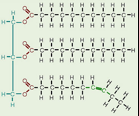
Fatty acids
|
|
|
What are most fats and oils; three fatty acids linked to a glycerol molecule (backbone)?
|
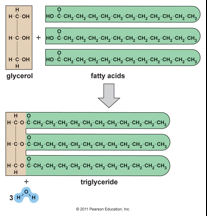
Triglycerides
|
|
|
What has the maximum possible hydrogen atoms attached to carbons in the backbone, animals tend to make these, they are straight, so they line up well, and stack tightly, and they are solid at room temperature: fats (butter, and lard)?
|
Saturated
|
|
|
What has less than the maximum number of hydrogens attached, have missing hydrogens cause links in fatty acid chain, don't line up or stack together well, plants tend to make these, and are liquid at room temperature: oils (corn oil, vegetable oil, olive oil- healthier than saturated fats)?
|
Unsaturated
|
|
|
What are bombard oils with H+ (ions), and fatty acids pick them up and become saturated (solid), contain "partially hydrogenated vegetable oil" (margarine, bakery products, french fries), and are considered unhealthy?
|
Trans fats
|
|
|
What has a carbon backbone that forms four rings (hydrogen and oxygen included), and has most of its hormones produced from cholesterol (testosterone, estrogen)
|
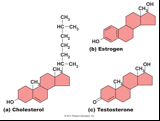
Steroids
|
|
|
How is cholesterol carried through our blood?
|
-Blood is mostly water so hydrophobic cholesterol doesn't travel well in blood
-Protein "escorts" called lipoproteins, bind to and carry cholesterol through blood -Two families of lipoproteins: HDL and LDL |
|
|
What tends to carry cholesterol to the liver where it is removed from the body ("good cholesterol")?
|
High Density Lipoproteins (HDL)
|
|
|
What keeps cholesterol inside the bloodstream where it is deposited on arteries walls (plaques), considered "bad cholesterol", and has higher risks for heart attacks and strokes?
|
Low Density Lipoproteins
|
|
|
What things raise LDL (bad) levels?
|
-Trans fats
-Obesity -Smoking -"Bad" genes- body makes lots of LDL and or cholesterol |
|
|
What things raise HDL (good) levels?
|
-Exercise
-"Good" genes- body makes lots of HDL and or little cholesterol |
|
|
What is a protein?
|

-No carbon-hydrogen backbone (does have both though)
-Amino acids= building blocks (aka peptides) -Chain of amino acids= polypeptide on protein -20 different amino acids -Humans have 10,000 different proteins |
|
|
What are amino acids?
|
-Built around a single central carbon (4)
-All amino acids have one hydrogen -All amino acids have a carboxylic acid (COOH) -Each of the 20 amino acids has a unique branch (R) |
|
|
How are the 8 essential amino acids different from the other 12?
|
-Our bodies can make 12 of 20 amino acids from scratch
-We cannot make the other 8 and must get them from our diet (Essential amino acids- EAA) -Plant proteins can be a poor source of EAA (vegetarians must choose carefully & mix; soybeans are good) |
|
|
What are some examples of the type of things proteins do in our bodies?
|

Nearly everything
|
|
|
What are the three major components of the cell theory?
|
1. All living things are made up of one or more cells
2. Cells are the basic unit of life (i.e. the smallest entity that displays all characteristics of life) 3. All cells are derived from other cells (no spontaneous generation) |
|
|
What cells are more complex (e.g. protists, plants, fungi, animals)?
|
Eukaryotic cells (eukaryotes)
|
|
|
What cells are simpler, and ancestral type (e.g. bacteria, and archaea)?
|
Prokaryotic cells (prokaryotes)
|
|
|
How are prokaryotes different than eukaryotes?
|
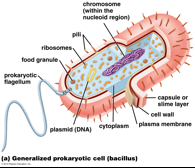
-Have a single circular chromosome (DNA)
-Occasionally, other tiny rings of DNA- plasmids -Neither inside a nucleus -No mitochondria, ER, or chloroplasts -Do have ribosomes, cell membranes, cell wall, flagella, cilia (called pili- sense of touch) |
|
|
-Bacteria, flea, whale, dandelion, oak
-To allow fast and different movement of molecules in and out of cell (crucial for life) -Bigger means more cells not bigger cells |
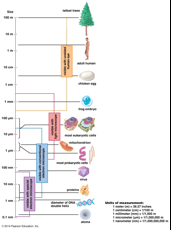
Point 1. Size- Cells must be small
|
|
|
-Function drives structure and structure drives function
-Many different types of cells- each with unique functions (jobs) -General pattern= a cells shape is well designed for what it does |
Point 2. Function determines structure
|
|
|
-A cell must be able to do everything an organism must do to stay alive
-Cells have many parts, each of which is responsible for one "job" (ex. a factory- billing, shipping, marketing, assembly, etc.) |
Point 3. Cells are complex both in structure and in function
|
|
|
What is the thin membrane that surrounds the cell, composed of a bilayer of phospholipids in which proteins are embedded?
|
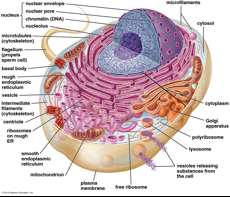
Cell/plasma membrane
|
|
|
What is the membrane bound central region that contains DNA?
|
Nucleus
|
|
|
What is everything inside the cell membrane and outside the nuclear membrane?
|
Cytoplasm
|
|
|
What is the fluid portion of the cytoplasm; the substance within the plasma membrane?
|
Cytosol
|
|
|
What is the combination of structures that produce an internal framework, and provides support, anchors structures, and allows transport within the cell (i.e. train tracks)?
|
Cytoskeleton
|
|
|
What is a short, hair-like, motile projection from the surface of certain eukaryotic cells?
|
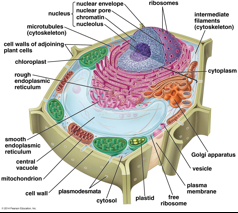
Cilia
|
|
|
What is a long, hair-like, motile extension of the plasma membrane?
|
Flagella
|
|
|
What converts glucose to ATP (energy)?
|
Mitochondria
|
|
|
What produces glucose from sunlight (plants only)?
|
Chloroplasts
|
|
|
What has two types: rough (with ribosomes)- makes protein, and smooth (no ribosomes)- makes lipids?
|
Endoplasmic reticulum (ER)
|
|
|
-Cells obtain energy from the outside environment in one form (food, light)
-Transform this energy into other forms the cell can use (especially the molecule called ATP) -Energy used for growth, repair, reproduction, and basic maintenance (no energy= death of cell) |
Point 4. Energy use by cells
|
|
|
What is a type of cell that can divide (produce more stem cells) but is capable of maturing into more than one copy of a cell?
|
Stem cell
|
|
|
What are cells from a very young embryo (64-128 cell stages) are TOTIPOTENT (all powerful), can become any of the 200+ type of cells in the body, and most promising for research designed to produce needed cells for medical problems: (pancreas- diabetes, nervous system-Alzheimer's/spinal cord injury, white blood cells- leukemia)
|
Embryonic stem cells
|
|
|
What are lots of stem cells throughout the adult body- PLURIPOTENT (multiple power), and are limited in what cells they become (e.g. blood stem cells only make- red blood cells, white blood cels, or platelets)
|
Adult stem cells
|
|
|
What are the areas of current/future research in stem cells?
|
-Removal of cells destroys the embryo- downside
(New lines of research): -Removal of embryonic cells without destroying embryos -Coax adult stem cells into becoming a wider variety of cell types or even turning back into embryonic cells -This would also prevent rejection issues |
|
|
What are some characteristics of the structure of a cell membrane?
|
-Selective permeable barrier around the cell:
-Allows correct things in/out of the cell -Prohibits incorrect things from entering/leaving -Flexible and dynamic: -Parts move around within the membrane -Promotes communication with other cells |
|
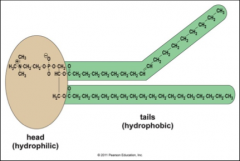
What is a primary component of membrane that has a double layer of phospholipids, phosphate containing hydrophilic (water-loving) "head", two hydrophobic fatty acids "tails" attached (saturated and unsaturated), tails face inward, towards each other, and head face outward, towards watery areas?
|
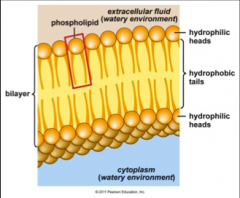
Phospholipid bilayer structure
|
|
|
How are phospholipids arranged to isolate the inside of the cell from the outside world?
|
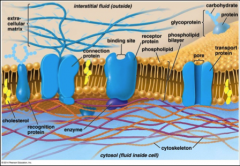
Hydrophilic-hydrophobic-hydrophilic layers restrict movement through the membrane
|
|
|
Why do membranes have cholesterol?
|
-All animal cell membranes have cholesterol molecules
- Provides flexibility to prevent damage -Brittle cells would break during normal use |
|
|
How does a cell transport things in and out if not directly through/across the phospholipid bilayer?
|
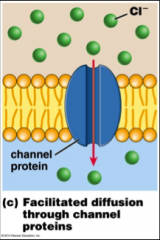
-Many types of proteins are embedded in the membrane
-Not anchored- move around the membrane as needed -Transport proteins (channels and carriers)- selectively allow molecules in/out of cells |
|
|
What other types of proteins are found in a cell membrane?
|
Recognition proteins, enzymes, receptor proteins, and attachment proteins
|
|
|
Which kind of protein "flags" that ID a cell as "self" to prevent attack by the immune system
|

Recognition proteins
|
|
|
Which kind of protein usually on the inside of the membrane, promotes chemical reactions inside a cell?
|

Enzymes
|
|
|
Which kind of protein provides a binding site outside the cell for hormones and other molecules outside the cell for hormones and other molecules that need to produce a response inside a cell?
|

Receptor proteins
|
|
|
Which kind of protein physically connects neighboring cells to each other?
|
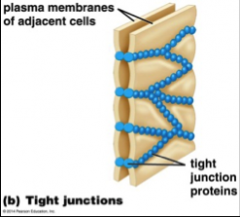
Attachment proteins
|
|
|
What types of things must be transported in/out of cells for life to persist?
|
-Critically important for cells to import/export molecules like:
-Nutrients (e.g. sugars, vitamins) -Gases (e.g. oxygen/carbon dioxide) -Cellular products (e.g. hormones) -Waste products |
|
|
Where can molecules cross the cell membrane?
|
-Through the phospholipid bilayer
-Very few e.g. tiny, or non-polar molecules (O2, CO2, water, alcohols, steroids) -Through transport proteins [channels, carriers] -Almost everything else (large, polar) |
|
|
What other transport options does a cell have to cross the cell membrane?
|
-Passively (using a concentration gradient); no energy required, (diffusion, facilitated diffusion, osmosis)
-Actively (against a concentration gradient); requires energy, active transport -Endocytosis/exocytosis for really big items |
|
|
What are some characteristics of concentration gradients?
|

-Molecules are always in motion
-Higher temperatures make molecules move faster (cooler=slower) -Motion stop at absolute zero -273C (32F= 0C, -100F= 23C) -Molecules try to spread out (evenly spaced) -This spreading out= diffusion |
|
|
How would you know which way diffusion would occur across a cell membrane?
|
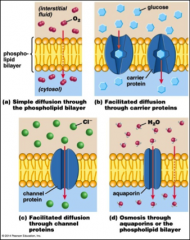
-Molecules move from areas of high concentration to areas of low concentration
-Along a gradient (unequal regions in a space) -Until concentrations are equal -Occurs in air and in fluids (passively) -Can be into or out of cell |
|
|
Which type of diffusion happens if molecules diffuse across a phospholipid bilayer?
|
Simple diffusion
|
|
|
Which type of diffusion happens if molecules pass through a transport protein (channel or carrier)?
|
Facilitated diffusion
|
|
|
Which type of diffusion happens if the molecule that is diffusing is water?
|
Osmosis
|
|
|
What kind of transport is being described:
-Sometimes cells must move molecules against the concentration gradient (low-high) -Cells must use energy to do this -Transport proteins called "pumps" use ATP to push molecules uphill against the gradient -30-40% of our metabolism |
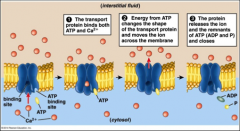
Active transport
|
|
|
What describes bringing items into the cell?
|

Endocytosis
|
|
|
What describes bringing in liquids (extracellular fluids and dissolved substances) into the cell?
|
Pinocytosis
|
|
|
What describes bringing in specific molecules only- that match the receptor?
|
Receptor-mediated endocytosis
|
|
|
What describes bringing non-specific large particles into the cell?
|
Phagocytosis
|
|
|
What describes expelling items out of the cell by packaging them into a vesicle (bubble)- the vesicle connects to the cell membrane and opens outward?
|
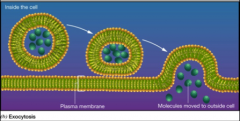
Exocytosis
|
|
|
What are some effect of venoms on cell membranes (snake/spider venoms)?
|
-Many contain enzymes called phospholipases (destroys phospholipids)
-Cause cell membranes to rupture or tear (kills the cell) -Many venoms specifically target cells of blood vessels (causes severe bleeding) |

